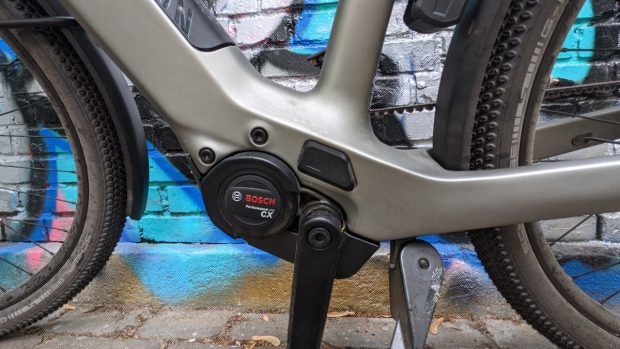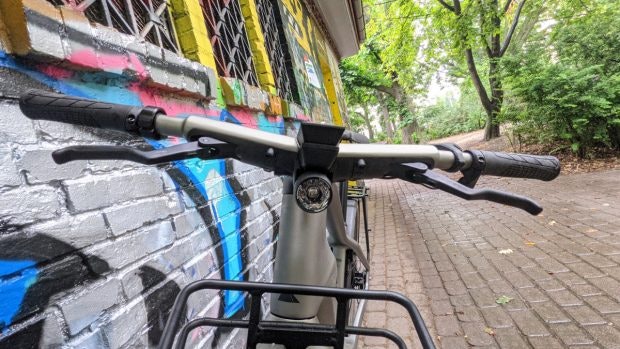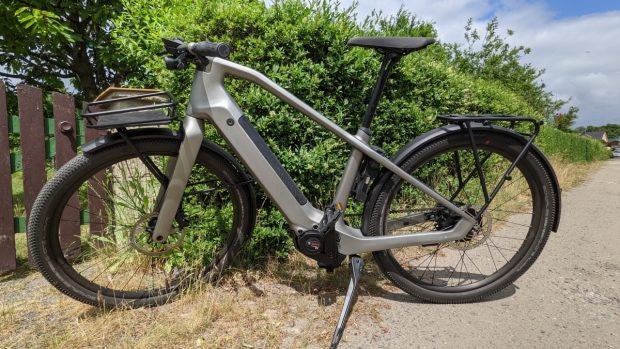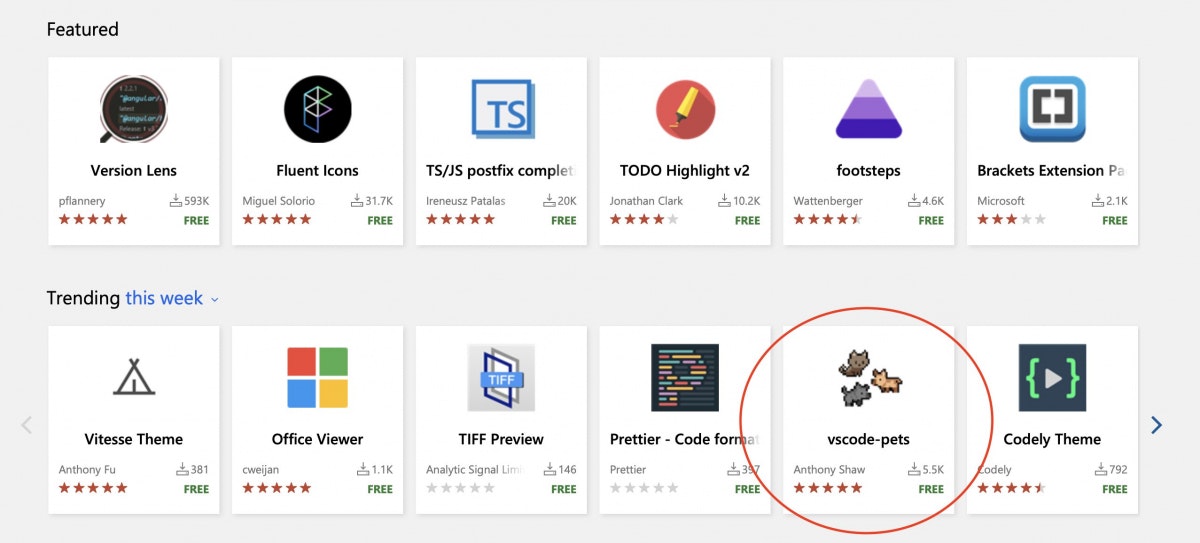This is what the noble pedelec can do for commuters
The Koblenz bike manufacturer Canyon is primarily known for its racing bikes, but also builds e-bikes for the city. We tried the Pedelec Canyon Precede-on 9, which is not only appealing because of its striking design, but is certainly not the right choice for everyone.
Canyon describes its Precede-on 9 as an urban pedelec for commuters that is in some parts similar to the Serial1 Cty / Rush (test) from Harley Davidson, but looks a bit more distinctive. The Precede-on 9 can be used as a kind of electrified variant of the Canyon Commuter to be understood on steroids. The two roughly share the design, whereby the pedelec looks a lot more beefy, which is due, among other things, to the battery integrated into the down tube and the correspondingly adjusted dimensions.
Contents
Canyon Precede-on 9: Commuter energized
The Canyon Precede: on CF 9. (Photo: t3n)
In terms of design, the Precede-on 9 is undoubtedly recognizable as a Canyon bike, because the Koblenz direct mail order company, like Vanmmoof, has managed to give its bikes a striking frame design with a clear recognition value. It starts with the stem handlebar unit with integrated cockpit and extends over the slightly angular frame with lowered top tube to the discreetly concealed stand, of which only a “nose” can be seen when folded. Canyon has also been able to transfer the refined and well thought-out design to a Precede-on-9 variant with a low entry, which the manufacturer offers in addition to the classic frame design.
In contrast to the Commuter model, Canyon relies on a carbon frame for its pedelec, the tubes of which appear to be thicker and made of one piece. The choice of materials gave the manufacturer scope for designing the frame, so that the removable battery could be seamlessly integrated into the down tube. In addition, the stem-handlebar unit is also made of carbon, which means that it merges almost seamlessly into the frame. Thanks to the material, the Kiox display and the brake levers are also deeply integrated into the handlebar element, which visually leaves a noble impression and also makes any cables and Bowden cables disappear. Even the headlight – with high beam – is part of the front-mounted unit, and the minimalist bell from Knog Oi fits in perfectly with the reduced cockpit design. The ergonomically shaped handlebar grips are pleasant and also suitable for longer tours.
Despite the light carbon material, the Precede-on is not a downright lightweight: It weighs around 23 kilograms. This makes it lighter than the Serial1 with its aluminum frame, which weighs 27 kilograms, but heavier than the e-bike models from Cowboy or Vanmoof. You don’t necessarily want to carry the Canyon to the fourth floor – because of the removable battery, this is not absolutely necessary either. But the pedelecs also differ in terms of price: At almost 5,000 euros, the Canyon is in the dimensions of the Serial1 and models from other renowned manufacturers. Among other things, the price should have something to do with the choice of material for the frame, but the other equipment of the pedelec is also decent. Cowboy and Vanmoof call up almost half.
Canyon Precede-on 9: Low-maintenance pedelec with a noticeable motor

The Canyon Precede: on CF 9 has a high-performance Bosch motor. (Photo: t3n)
The drive is minimalistic and requires little maintenance: Canyon uses a Gates carbon belt and an automatic Enviolo-Automatiq gear hub for the Precede-on 9. The combo is already known to us from the Serial1 and was particularly noticeable for its easy-care operation. Thanks to the fourth generation of the Bosch Performance CX mid-engine with 250 watts, with a maximum torque of up to 85 Newton meters, you can get anywhere in a flash and reach the maximum electric speed of 25 kilometers per hour. However, the motor is not one of the quietest types: It is always easy to hear, which is not always the case with drives from other manufacturers.
As with all other pedelecs, with the Canyon the cyclist has to work out every speed exceeding 25 kilometers per hour with their own muscle power. Depending on how well the automatic system has been set, this takes a lot of effort. The desired cadence can also be set to a limited extent while driving via the Kiox display and the five-button control element attached to the left handlebar grip. When it comes to recruitment, however, it is important to try it out in order to find the right cadence for your own driving style.
With the control element, we would have liked a slightly better tactile distinction between the buttons, so that the user interface of the Kiox interface can be navigated more intuitively and “blindly”. Sure, after a bit of getting used to it, it was less a try than a finding. There is still room for improvement.
Canyon Precede-on 9 with Kiox system from Bosch
Now we come to the Kiox display: The screen shows the current, average and highest speed, among other things. The distance covered, the time, the charge level of the battery, the support level and all sorts of other things are also displayed. For the support levels, you can choose between the modes “Off” (without electrical support) and “Eco”, “Tour”, “Sport” and “Turbo”. As the name suggests, the greatest boost of the electrical stages is provided by the turbo mode, which pays off especially at traffic lights for urban traffic. Because with this you can accelerate almost as with a Vanmoof with a turbo button in green and sit in front of the fellow cyclists. Of course, this also uses a little more energy than the other modes, but it’s a lot of fun.
Using a corresponding smartphone app for Android and iOS, you can evaluate your trips and even view detailed values about your driving behavior. You even get information about the distribution of forces between you and the bike. The more energy you have invested in the drive, the longer the battery will last.
Where we are now at the built-in battery, which with 500 watt hours is not the largest, but is fully sufficient for city traffic: Depending on your personal driving style, it can cover around 60 to 80 kilometers – with the lower support level even more. If the battery is empty, you can easily remove it from the top and charge it in your apartment with the supplied charger. If you have a ground-level charging option, you can also leave the battery in the bike and “refuel” using the charging connection integrated in the frame.
And how does the Canyon Precede-on 9 ride?
Apart from its rather beefy appearance, the Canyon e-bike has a rather long wheelbase and a deep bottom bracket. Thanks to the wheelbase, the pedelec offers extremely smooth running and very safe driving behavior. The relatively large turning circle associated with the wheelbase is hardly noticeable on most routes and is not a major obstacle. What struck me on our tours with the Precede: When taking deep corners, you should always make sure that you have the right pedals down because of the deep bottom bracket, otherwise you could also have contact with the road.

The front light of the Canyon Precede: on CF 9 also masters far light. (Photo: t3n)
In terms of general riding comfort and seating position, Canyon delivers a very good bike. Our size M test model fit the tester’s height of 1.74 meters perfectly. The seating position felt compact, but not compressed and ideal for city traffic as well as for medium-long journeys. The pedelec feels most comfortable on asphalt, but the 2.25-inch thick and 27.5-inch Schwalbe G-One all-round tires are also on slightly unpaved roads and not too bumpy cobblestones, supported by the splayed seat post that resembles a spring works, easily gone. It should also be mentioned here that even on uneven paths nothing rattles or the bike makes other noises. It is processed absolutely excellently.
For taller riders: inside there is the Precede-on in the other frame sizes L and XL. The aforementioned step-thru model even goes down to size XS. This variant is adapted for people who are shorter than 1.60 meters. Unfortunately, it is rare for manufacturers to offer their bikes in such a range.
If you want to use the Precede-on as a delivery donkey, you have the option of loading the rear Racktime luggage rack with up to 25 kilograms. A spring flap is not on board, as is the case with many bikes now, but it is easy to attach luggage bags with a Q3LB1 system from Ortlieb. There are also mounting points for a lowrider on the carbon rigid fork, but only five kilograms can be transported.
Trailers can also be towed with the Precede-on 9 – at least Canyon offers a compatible coupling for Croozer trailers. Incidentally, the total permitted weight of the bike is 140 kilograms.
Canyon Precede-on 9: Premium pedelec for commuters, not for speeders

The Canyon Precede: on CF 9 (Photo: t3n)
The Canyon Precede-on 9 is an excellently processed pedelec with a distinctive design that attracts attention on the road and after which other road users will turn around. The futuristic design won’t appeal to everyone, but Canyon can be sure that it made a lasting impression. But when it comes to cycling, optics are only a minor matter, the most important thing is how it rides – and in this discipline the e-bike impresses with its high level of ride comfort and smoothness. In addition, it is characterized by safe driving behavior.
However, the Enviolo automatic gearshift is not necessarily something for sporty drivers who want to drive fast over the long term. You’d better get Precede-on 8 look at, which is even a little cheaper if it has to be a similar canyon. The somewhat cheaper 8-series model has a classic twelve-way Shimano derailleur gears with almost identical equipment, which allows a greater range of gears. Both models, however, have the same battery installed, which is in the middle range with its range and should be sufficient for city traffic, especially since it can be easily removed and charged. Both models have the same audible motor – that of the Roadlite-on is quieter and has a Fazua motor has installed.
Despite the criticisms, the Precede-on 9 is a lot of fun, although it may not be the right model for everyone. Anyone who primarily wants to use the bike for commuting or relaxed, yet quite brisk journeys or excursions will receive an excellent pedelec if the easily audible engine noises do not mind.


